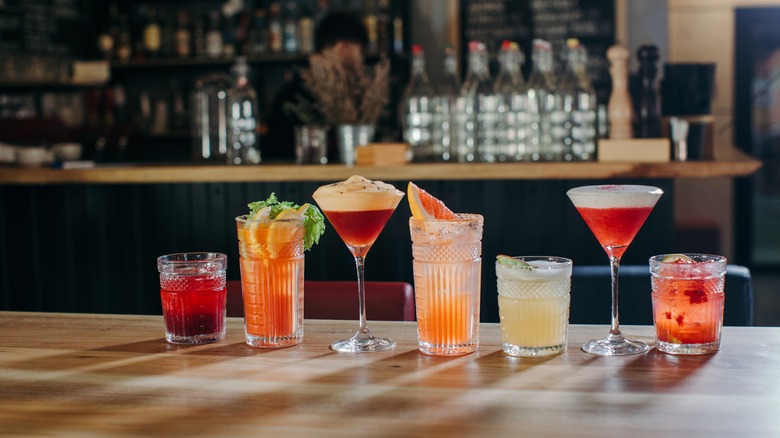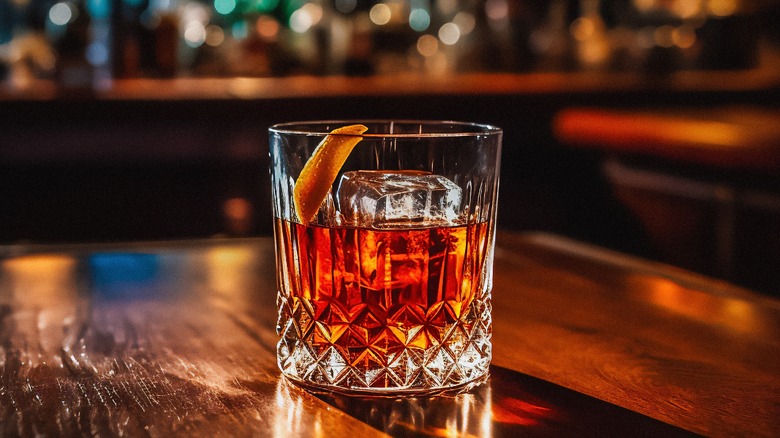What Is A Rocks Glass And What Drinks Are Served In It?
Are you perfecting those home bartending skills? If so, you're probably stocking your alcohol cabinet and collecting all the necessary bar equipment. This inevitably includes glassware, and as you research which vessels to buy, multiple sources have likely recommended rocks glasses. If you're new to home bartending, you might wonder what these are and what they're used for. Luckily, we're here to break down all the details.
Rocks glasses are short and wide glassware. Some display pressed glass designs, while others have a smooth, uniform exterior. However, they all have a sturdy base, making them easy to store without worrying they'll tip over and break. As such, you can forget the delicate air of the long-stemmed wine glass or iconic martini glass shape. Rocks glasses have some weight behind them, which feels satisfying in your hand. A rocks glass holds 6-12 ounces, and given the shape and size, it's ideal for drinks served neat or — no surprise here — on the rocks. Despite its height, it has enough room to hold liquor, a mixer, and a substantial amount of ice. However, bartenders tend to favor these glasses for higher-proof cocktails like old fashioneds and negronis. And because of the heavy bottom, it's durable enough to sustain muddling, meaning cocktails can be built directly in a rocks glass: Think Negronis, sazeracs, or white Russians.
Now you know what to put in your rocks glass. But how do you use one when mixing cocktails? And how does it differ from old fashioned and lowball glasses? We're serving this information straight up, so get ready to take notes and improve those bartending skills.
How to use a rocks class when crafting cocktails
When building cocktails, there's some discrepancy among bartenders as to whether to add the ice first, so we'll let you experiment and see what works best for you. As far as ingredients go, order matters. In general, follow the recipe instructions. If you're free-flowing, start with the primary liquor, followed by subsequent liquors and liqueurs, and then the non-alcoholic mixers. Don't forget to give your cocktail a few gentle swirls with a cocktail spoon and garnish appropriately before serving.
Rocks glasses also come in handy when making muddled drinks. Thanks to a solid base, these glasses can handle pressure without breaking. If you're making a caipirinha, you can muddle the sugar and fruit directly in the glass before adding liquor, mixers, and ice. Muddling cocktails in rocks glasses is especially convenient when you don't need to strain them. You don't want to filter out the fruit or herbs with caipirinhas or mint juleps, as these bits only add to the flavor. Of course, you can always strain cocktails into a rocks glass. However, when your mixing vessel is also used for drinking, little cleanup is required.
What's the difference between rocks, old fashioned, and lowball glasses?
The terms for rocks, old fashioned, and lowball glasses are often used interchangeably. Likewise, drinks in one of these glasses will usually work in the others. However, some slight differences separate these three.
First, a lowball is a general term encompassing glasses that are, well, shorter than highballs. Both rocks and old fashioned glasses fit this criteria. So what separates rocks glasses from old fashioned? Rocks glasses tend to be larger, while old fashioned glasses are smaller, holding 6-8 ounces. Some may even refer to rocks glasses as double old fashioned glasses.
The old fashioned glass is (naturally) built for the cocktail of the same name. With few ingredients, the standard old fashioned cocktail is under 3 ounces. As such, it looks more appealing in a shorter, smaller glass. That said, it can most certainly be served in a rocks glass. Ultimately, opt for the rocks if you're buying glassware and need to choose between the two. It's simply more versatile. For example, this whiskey sour recipe yields 4½ ounces plus ice, which will fit much more neatly in a rocks glass.


